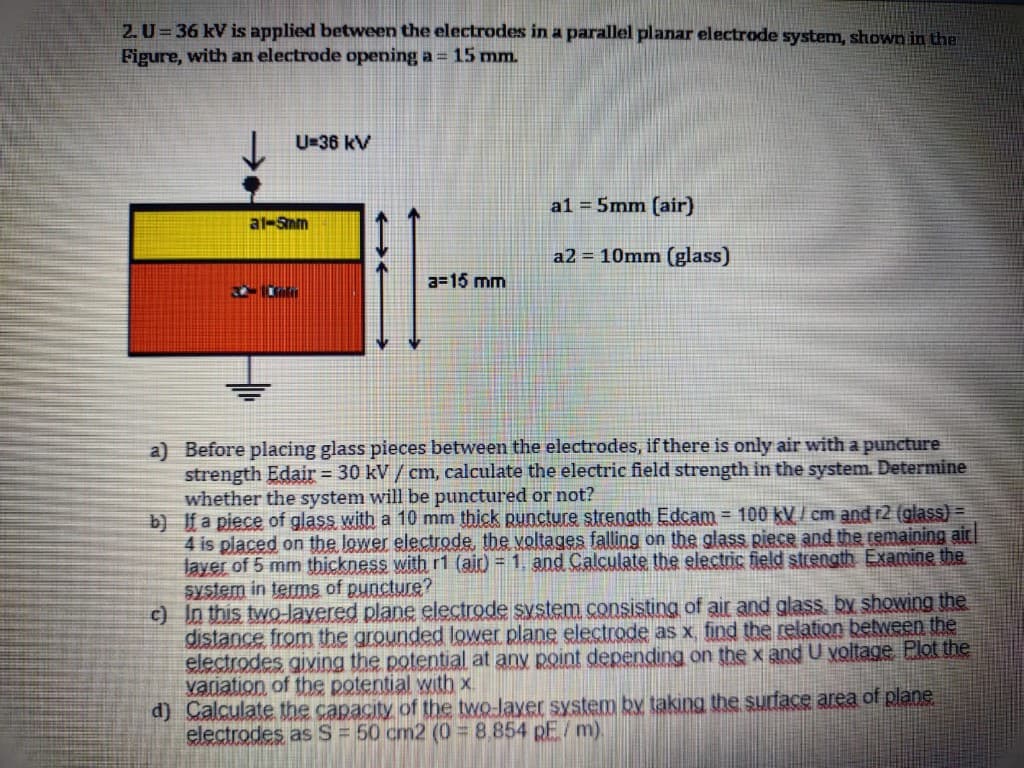2. U=36 kV is applied between the electrodes in a parallel planar electrode system, shown in the Figure, with an electrode opening a = 15 mm. | U=36 kV al = 5mm (air) al-Smm a2 = 10mm (glass) a=15 mm a) Before placing glass pieces between the electrodes, if there is only air with a puncture strength Edair= 30 kV / cm, calculate the electric field strength in the system. Determine whether the system will be punctured or not? b) If a piece of glass with a 10 mm thick puncture strength Edcam = 100 kV / cm and r2 (glass) 4 is placed on the lower electrode, the voltages falling on the glass Riece and the remaining ait! layer of 5 mm thickness with r1 (air) = 1, and Calculate the electric field strength Examine the system in terms of puncture? c) In this two-Jayered plane electrode system consisting of air and glass, by showing the distance from the grounded lQwer plane electrode as x, find the relation between the electrodes giving the potential at any point depending on thex and U voltage Plot the variation of the potential with x. d) Calculate the capacity of the two-layer system by taking the surface area of plane electrodes as S = 50 cm2 (0 8.854 pF/ m).
2. U=36 kV is applied between the electrodes in a parallel planar electrode system, shown in the Figure, with an electrode opening a = 15 mm. | U=36 kV al = 5mm (air) al-Smm a2 = 10mm (glass) a=15 mm a) Before placing glass pieces between the electrodes, if there is only air with a puncture strength Edair= 30 kV / cm, calculate the electric field strength in the system. Determine whether the system will be punctured or not? b) If a piece of glass with a 10 mm thick puncture strength Edcam = 100 kV / cm and r2 (glass) 4 is placed on the lower electrode, the voltages falling on the glass Riece and the remaining ait! layer of 5 mm thickness with r1 (air) = 1, and Calculate the electric field strength Examine the system in terms of puncture? c) In this two-Jayered plane electrode system consisting of air and glass, by showing the distance from the grounded lQwer plane electrode as x, find the relation between the electrodes giving the potential at any point depending on thex and U voltage Plot the variation of the potential with x. d) Calculate the capacity of the two-layer system by taking the surface area of plane electrodes as S = 50 cm2 (0 8.854 pF/ m).
Introductory Circuit Analysis (13th Edition)
13th Edition
ISBN:9780133923605
Author:Robert L. Boylestad
Publisher:Robert L. Boylestad
Chapter1: Introduction
Section: Chapter Questions
Problem 1P: Visit your local library (at school or home) and describe the extent to which it provides literature...
Related questions
Question
100%
Answers:
a)24 kV/cm
b) U1= 24 kV, U2= 12 kV, E1=48 kV/cm, E2= 12 kV/cm
c) 5,9 pF

Transcribed Image Text:2. U= 36 kV is applied between the electrodes in a parallel planar electrode system, shown in the
Figure, with an electrode opening a = 15 mm.
U=36 kV
a1 = 5mm (air)
at-Snm
a2 = 10mm (glass)
a=15 mm
a) Before placing glass pieces between the electrodes, if there is only air with a puncture
strength Edair= 30 kV / cm, calculate the electric field strength in the system. Determine
whether the system will be punctured or not?
b) f a piece of glass with a 10 mm thick puncture strength Edcam = 100 kV / cm and r2 (glass) =
4 is placed on the lower electrode, the voltages falling on the glass Riece and the remaining ait
layer of 5 mm thickness with r1 (ai) = 1, and Calculate the electric field strength Examine the
system in terms of puncture?
c) In this two-Jayered plane electrode system consisting of air and glass, by showing the
distance from the grounded lower plane electrode as x, find the relation between the
electrodes giving the potential at any point depending on the x and U voltage Plot the
variation of the potential with x.
d) Calculate the capacity of the two-layer system by taking the surface area of plane
electrodes as S = 50 cm2 (0 8.854 pF/m).
Expert Solution
This question has been solved!
Explore an expertly crafted, step-by-step solution for a thorough understanding of key concepts.
Step by step
Solved in 2 steps

Knowledge Booster
Learn more about
Need a deep-dive on the concept behind this application? Look no further. Learn more about this topic, electrical-engineering and related others by exploring similar questions and additional content below.Recommended textbooks for you

Introductory Circuit Analysis (13th Edition)
Electrical Engineering
ISBN:
9780133923605
Author:
Robert L. Boylestad
Publisher:
PEARSON

Delmar's Standard Textbook Of Electricity
Electrical Engineering
ISBN:
9781337900348
Author:
Stephen L. Herman
Publisher:
Cengage Learning

Programmable Logic Controllers
Electrical Engineering
ISBN:
9780073373843
Author:
Frank D. Petruzella
Publisher:
McGraw-Hill Education

Introductory Circuit Analysis (13th Edition)
Electrical Engineering
ISBN:
9780133923605
Author:
Robert L. Boylestad
Publisher:
PEARSON

Delmar's Standard Textbook Of Electricity
Electrical Engineering
ISBN:
9781337900348
Author:
Stephen L. Herman
Publisher:
Cengage Learning

Programmable Logic Controllers
Electrical Engineering
ISBN:
9780073373843
Author:
Frank D. Petruzella
Publisher:
McGraw-Hill Education

Fundamentals of Electric Circuits
Electrical Engineering
ISBN:
9780078028229
Author:
Charles K Alexander, Matthew Sadiku
Publisher:
McGraw-Hill Education

Electric Circuits. (11th Edition)
Electrical Engineering
ISBN:
9780134746968
Author:
James W. Nilsson, Susan Riedel
Publisher:
PEARSON

Engineering Electromagnetics
Electrical Engineering
ISBN:
9780078028151
Author:
Hayt, William H. (william Hart), Jr, BUCK, John A.
Publisher:
Mcgraw-hill Education,